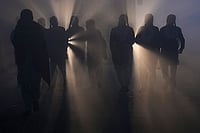Taking a leaf from President Xi Jinping’s book on connectivity, leaders of India, Saudi Arabia, UAE, France, Germany, Italy, the United States, and the European Union (EU) have come out with the announcement of a memorandum of understanding (MOU) on a new India-Middle East-Europe Economic Corridor (IMEC) to unlock the economic potential of the region.
If IMEC takes off, it will give a massive fillip to both continents. But this is at the moment just on paper and getting it started an functioning will take a decade and more — provided all countries remain on board several years down the line. The project cannot be insulated from political head winds, including elections and change of governments and unforeseen events that could sweep out many countries that have signed in for now.
The statement announcing IMEC said: “A special event on Partnership for Global Infrastructure and Investment (PGII) and India-Middle East-Europe Economic Corridor (IMEC) on 9 September 2023 on the sidelines of the G20 Summit in New Delhi….The event aimed at unlocking greater investment for infrastructure development and strengthening connectivity in its various dimensions between India, Middle East and Europe. The IMEC comprises of an Eastern Corridor connecting India to the Gulf region and a Northern Corridor connecting the Gulf region to Europe. It will include a railway and ship-rail transit network and road transport routes.”
Calling it a mega-project, the US readout further explains: “This landmark corridor is expected to stimulate economic development through enhanced connectivity and economic integration across two continents, thus unlocking sustainable and inclusive economic growth.”
The agreement will connect India through ports, shipping routes, and rail corridors to countries in the Middle East and then Eastern and Western Europe.
US President Joe Biden and several analysts are already calling the proposal a gamechanger, but as the old proverb says, there is many a slip between the cup and lip.
“Two things strike me about this initiative: first, the suggested scale of investment is an indication of how seriously the Saudis and UAE take India and India’s economic potential,” says Prof. Ian Hall, an international relations expert at Brisbane’s Griffith University. “But second, the purpose of the infrastructure, apart from offering an alternative to BRI projects, still isn’t clear. It is expensive to ship oil and gas over land, so energy probably isn’t the main game. Is it about Indian exports into the Middle East then? And of what? Perhaps food or manufactured goods like cars. We don’t have enough details yet to evaluate it.”
Much of this connectivity drive is aimed at containing China’s Belt and Road Initiative (BRI), the big idea first put on the table by Xi in 2013. Countries in Central Asia, South Asia, the Middle East, and several African nations had signed on to the proposal that was funded mainly by China’s government-owned banks. But many of the countries, including Sri Lanka, have got into a debt trap over their inability to pay back. The same has happened to some African countries.
India has consistently opposed the BRI and has refused to be part of it, thanks to the fact that the China-Pakistan Economic Corridor (CPEC) runs through Pakistan Occupied Kashmir (POK) that India considers as its own territory illegally occupied by Pakistan. Italy, an important signatory of China’s BRI, has just pulled out of the arrangement.
The centrepiece of the BRI is the development of the Gwadar port in Pakistan and railway infrastructure in the restive Balochistan province. The CPEC connects through the 2000km road and railway network including Kashgar in West China autonomous region to the port city. The deal was supposed to be a gamechanger and transform the mineral-rich underdeveloped region into a thriving commercial hub. However, the province is not thriving, though much of it has little to do with the CPEC and more to do with internal disturbance in Balochistan.
The nitty-gritty of the economic corridor has perhaps not yet been worked out or talked about publicly. The financing is also not yet known.
Most experts feel it’s too early to comment, but as an idea, the IMEC is getting top marks and has the potential to transform the economy of the countries it would pass through.
“Various ambitious announcements like the EU Global Gateway, US Build Back Better, and India- EU connectivity now have a peg to hang on with this futuristic and visionary idea,’’ says former Indian ambassador Gurjit Singh.
While everyone agrees that the signing of IMEC’s MOU has tremendous potential, how it will finally turn out depends on many factors. For now, one can just wait and watch until more is known.
“If funded and implemented, this will be good for India, the Gulf, and Europe. Biden had discussed this with the Saudis in July 2022 when he visited them. The Saudis refused to normalise relations with Israel but agreed to join this project. If it works out, Indians, especially the technically-qualified ones, might find more job opportunities in the GCC where some countries like Kuwait are hoping to reduce the number of foreigners,” says former Indian ambassador KP Fabian.



























